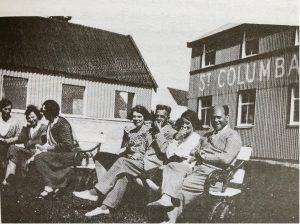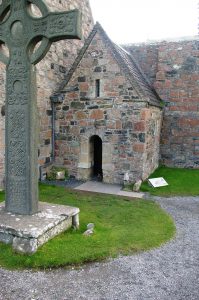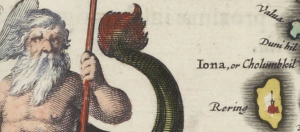Thomas Owen Clancy


Columba, the Latin form of his name, is the way he appears in the earliest full text about Iona, Adomnán’s Vita Sancti Columbae, ‘The Life of Saint Columba’, and it is also the main way in which the saint is referred to in modern scholarship and in modern English usage. In between, in Gaelic, the local language of Iona, his name had other forms, which we will discuss below. For this reason, on Iona, names which contain ‘Columba’ are usually quite recent in one way or another. Think here of the ‘St Columba Hotel’, one of the only places on Iona to bear the saint’s name in this way for any length of time — in this case, since around 1868.
A number of features have acquired Columba’s name over recent years, owing to traditions, or sometimes speculations, about connections with the saint, for instance ‘St Columba’s Pillow’,[1] or ‘St Columba’s Table’. Some English place-names containing Columba are also recent, it not having been there in the original Gaelic name. An instance of this is ‘Columba’s Bay’, a comparatively recent creation for what is still known in Gaelic as Port a’ Churaich, the site where, traditionally, the saint landed his boat.[2] So, while stories and traditions of Columba haunt so many places and monuments on Iona, as Columba his name was only recently embedded in its place-names.
Of course, Columba was his name in Latin. In Gaelic his name was Colum (modern Calum, and originally, in Early Gaelic, Columb). This was a name originally derived from the Latin word columba meaning a dove, a fact which Adomnán plays with in the opening section of his Life of Saint Columba. Colum, and names created from it like Colmán, seem to have been very popular in the early medieval Gaelic world, particularly for churchmen. Adomnán mentions several other individuals called Columb, one a priest, another a pious iron-smith; and numerous people named Colmán, all ostensibly alive at the same time as Columba. The records of the saints of the Gaelic world found in the collection called Corpus Genealogiarum Sanctorum Hiberniae lists several hundred Colmáns and the like.[3] Perhaps to distinguish him from all these others, Columba early on developed the Gaelic name Colum Cille, ‘Columba of the church’, often rendered as ‘dove of the church’.
We don’t know precisely when he acquired this name. Marjorie Anderson reckoned that since Adomnán did not use this form of his name, it was developed later than the Life (which was finished around 700), but other texts suggest this is not correct. He may even have acquired the name even when he was alive, if the poem Amrae Coluimb Chille, said to have been composed at his death, is genuinely from then, since it calls him ‘Colum Cille’ in one line. Even if it is not, we find this name in poetry certainly of the mid-seventh century by the poet Beccán mac Luigdech, perhaps the same person as Beccán of Rum who died in 677. In one poem he pleads:
Rom-ain ar thein – tress cach oín –
Columb Cille, caindel sóer‘May he save me from fire – common fight –
Colum Cille, noble candle’
In another, he riffs constantly on the name:
Columb Cille, Columb boíë, Columb biäss,
Columb bithbéo – ní hé sin in snádud ciäss.‘Colum Cille, Colum who was, Colum who will be,
Constant Colum, not he the protection to be lamented.[4]
So, Columba’s Gaelic name was Colum Cille, from as early as the mid-seventh century if not earlier. Nonetheless, even in this form his name is strikingly absent from the Iona landscape. There are plenty of other saints in that landscape: churches and graveyards commemorating Odhran (Odrán), Coinneach (Cainnech / Kenneth), Ronan (Ronán), Michael, Mary, and the obscure Mo Ghobhannan and Mo Neachdain; crosses commemorating John and Martin, Adomnán and Brendan; ports of Adomnán and Ronan. But no Colum Cille.

The one exception to this absence is the small chapel that lies just outside the cathedral entrance, which was traditionally the relic shrine for Columba’s body. Martin Martin called it ‘St Columbus’s Tomb’ in his account from 1695, a status that has been reaffirmed in recent investigations, meriting the name ‘St Columba’s Shrine Chapel’. It is likely this early medieval structure was referred to in Old Norse as Kolumkilla kirkju inni lítlu ‘the little church of Colum Cille’, in the 13th-century Norse text Saga Magnús konungs berfœtts (King Magnus Barelegs’ Saga), suggesting that its association with the saint in a place-name was current at that time.[5] But beyond this it is striking how in an island so rich in associations with the saint, his name is comparatively absent. But perhaps it is precisely because he was everywhere, that nowhere, except perhaps the chapel where his body lay, encoded his name.
Or perhaps it is because the island itself embodied the saint. While modern English usage calls the island Iona; and in Gaelic it can be simply Ì, or Eilean Idhe, for much of its existence the island was known also as Ì Chaluim Chille, or earlier variations on that name (an exploration of the problematic name Ì will have to await another occasion).[6] The earliest use of this form of the name of the island I am currently aware of is in the Annals of Ulster for 802: I Columbae Cille a gentibus combusta est ‘Ì Coluim Chille was burned by the heathens [i.e., by Vikings]’. The usage is found throughout the later middle ages and early modern period, and continues still.[7]
Why? There are other monasteries within the Gaelic world which bore the name of their founder saint, but usually this was to distinguish monasteries with similar names one from the other, for instance, Cluain Ferta, Clonfert, of which there were several, and so Cluain Ferta Brénaind (‘Clonfert of St Brendan’), Cluain Ferta Mo Lúa, Clonfertmulloe (Clonfert of Mo Lúa). But to the best of my knowledge there was nowhere else called Ì.
It does seem then that by the early ninth century at the latest, the association between the island, and the name of the founding saint of the monastery on it, was so close that they became fused in the island’s name: Ì Coluim Chille, Ì Chaluim Chille, St Columba’s Iona.

[1] The stone commonly referred to as St Columba’s Pillow was found around 1870. The name derives from speculations first put forward by James Drummond in Proceedings of the Society of Antiquaries of Scotland 10 (1870-72), 613-17, which can be found here.
[2] Dr Mairi MacArthur has noted the occasional re-translation into Gaelic of the English name by non-locals as Bagh Chaluim Chille: see her ‘Celebrating Columba on Iona, 1897 and 1997’, in T.O. Clancy and Dauvit Broun (eds), Spes Scotorum, Hope of Scots: Saint Columba, Iona and Scotland (Edinburgh, 1999), 245-51, at 250.
[3] Pádraig Ó Riain, Corpus Genealogiarum Sanctorum Hiberniae (Dublin, 1985), 233-35
[4] T.O. Clancy and Gilbert Márkus, Iona: The Earliest Poetry of a Celtic Monastery (Edinburgh, 1995), pp. 140-41, 148-49; and see 108-9 for the reference in the Amrae. The early date of the Amrae has been questioned recently in Jacopo Bisagni, Amrae Coluimb Chille: A Critical Edition (Dublin, 2019).
[5] Martin Martin, A Description of the Western Islands of Scotland, second edition (London, 1716; reprint Edinburgh 1970), 258-9; Finnur Jónsson, Snorri Sturluson, Heimskringla: Nóregs Konunga Sögur (Copenhagen, 1893), 245; online edition from 1911 at: http://heimskringla.no/wiki/Saga_Magn%C3%BAs_konungs_berf%C5%93tts_(FJ), see §9. For the shrine chapel in the most recent view of archaeologists, see Ewan Campbell and Adrián Maldonado, ‘A New Jerusalem “at the ends of the earth”: interpreting Charles Thomas’s excavations at Iona Abbey 1956–63’, The Antiquaries Journal 100 (2020), 33-85: DOI: https://doi.org/10.1017/S0003581520000128.
[6] Dr Alasdair Whyte discussed versions of the name and their origins in Round and About, May 2020.
[7] https://celt.ucc.ie//published/G100001A/index.html at 802.9
